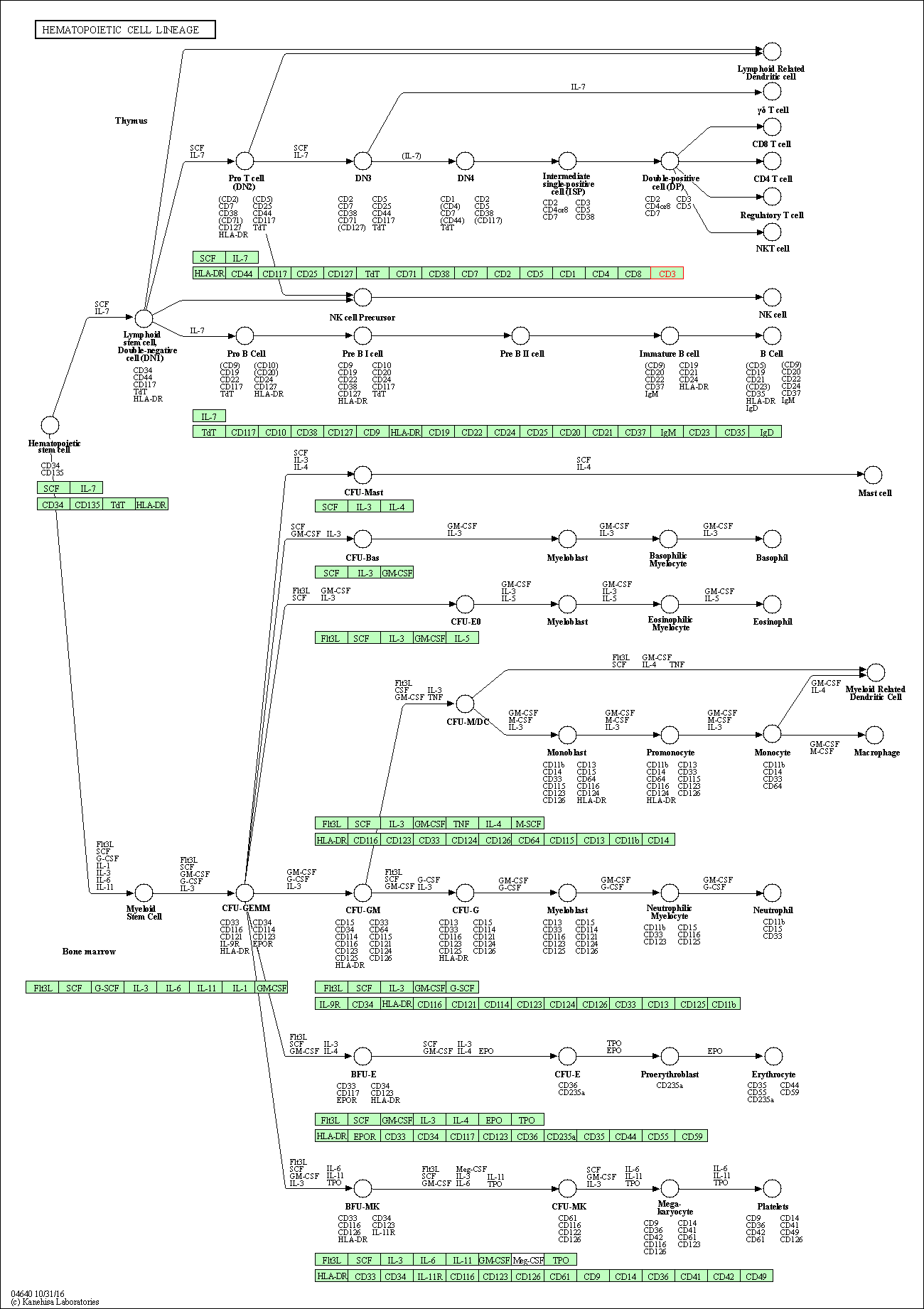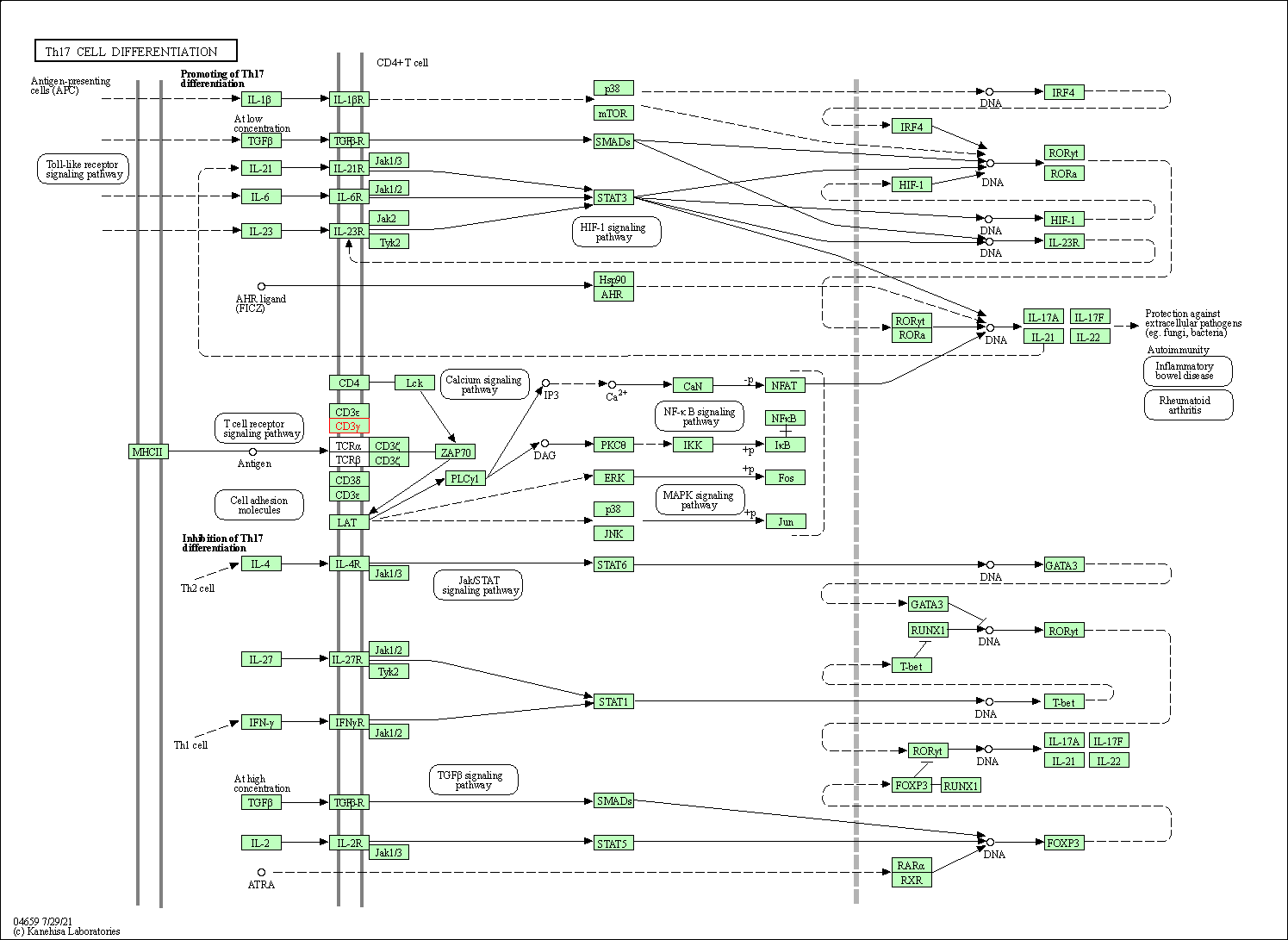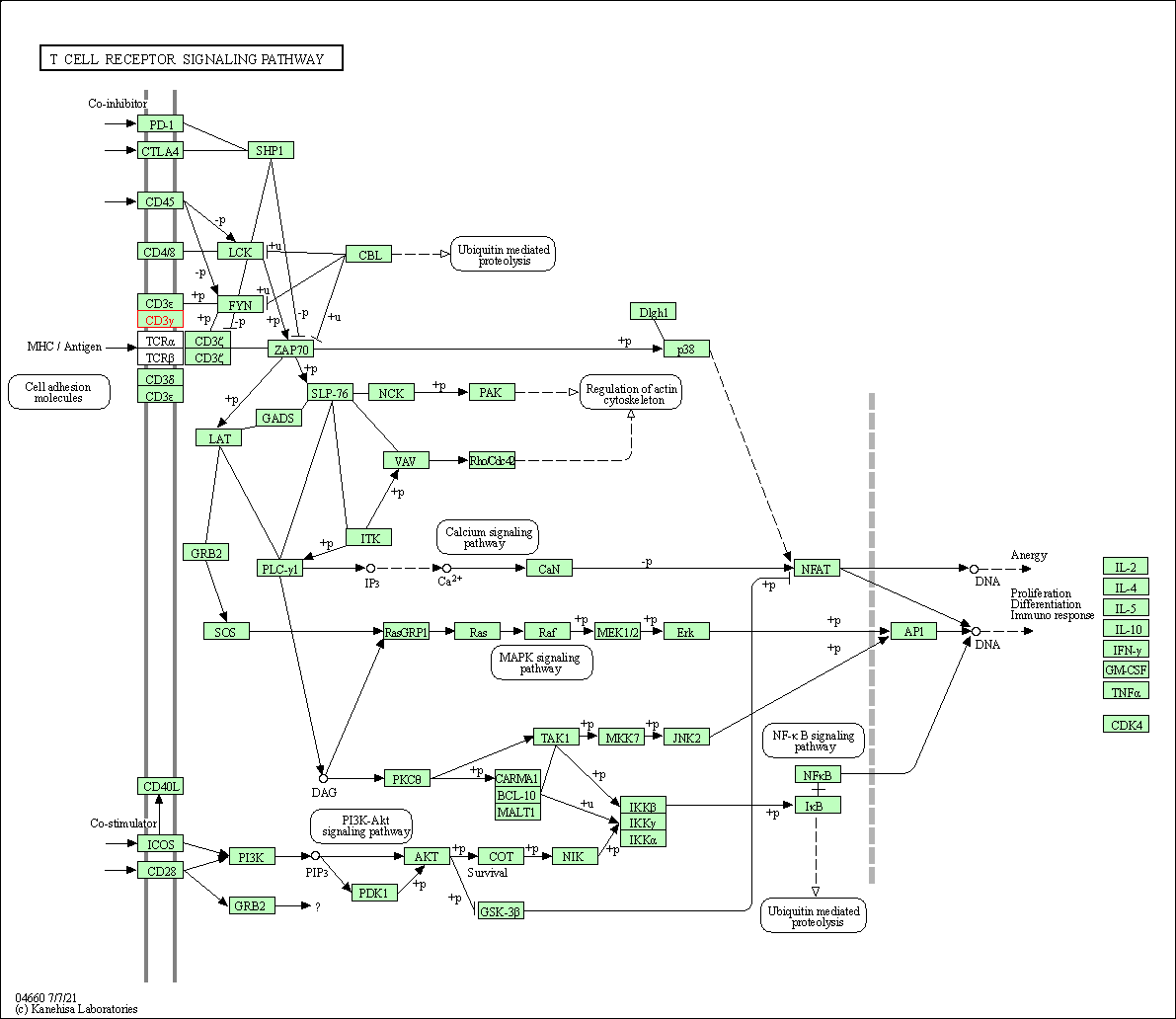Target Information
| Target General Information | Top | |||||
|---|---|---|---|---|---|---|
| Target ID |
T18972
(Former ID: TTDNC00504)
|
|||||
| Target Name |
T-cell surface glycoprotein CD3 gamma (CD3G)
|
|||||
| Synonyms |
T3G; T-cell surface glycoprotein CD3 gamma chain; T-cell receptor T3 gamma chain; CD3g
Click to Show/Hide
|
|||||
| Gene Name |
CD3G
|
|||||
| Target Type |
Clinical trial target
|
[1] | ||||
| Disease | [+] 5 Target-related Diseases | + | ||||
| 1 | Colorectal cancer [ICD-11: 2B91] | |||||
| 2 | Breast cancer [ICD-11: 2C60-2C6Y] | |||||
| 3 | Malignant digestive organ neoplasm [ICD-11: 2C11] | |||||
| 4 | Prostate cancer [ICD-11: 2C82] | |||||
| 5 | Solid tumour/cancer [ICD-11: 2A00-2F9Z] | |||||
| Function |
When antigen presenting cells (APCs) activate T-cell receptor (TCR), TCR-mediated signals are transmitted across the cell membrane by the CD3 chains CD3D, CD3E, CD3G and CD3Z. All CD3 chains contain immunoreceptor tyrosine-based activation motifs (ITAMs) in their cytoplasmic domain. Upon TCR engagement, these motifs become phosphorylated by Src family protein tyrosine kinases LCK and FYN, resulting in the activation of downstream signaling pathways. In addition to this role of signal transduction in T-cell activation, CD3G plays an essential role in the dynamic regulation of TCR expression at the cell surface. Indeed, constitutive TCR cycling is dependent on the di-leucine-based (diL) receptor-sorting motif present in CD3G. Part of the TCR-CD3 complex present on T-lymphocyte cell surface that plays an essential role in adaptive immune response.
Click to Show/Hide
|
|||||
| UniProt ID | ||||||
| Sequence |
MEQGKGLAVLILAIILLQGTLAQSIKGNHLVKVYDYQEDGSVLLTCDAEAKNITWFKDGK
MIGFLTEDKKKWNLGSNAKDPRGMYQCKGSQNKSKPLQVYYRMCQNCIELNAATISGFLF AEIVSIFVLAVGVYFIAGQDGVRQSRASDKQTLLPNDQLYQPLKDREDDQYSHLQGNQLR RN Click to Show/Hide
|
|||||
| 3D Structure | Click to Show 3D Structure of This Target | PDB | ||||
| Drugs and Modes of Action | Top | |||||
|---|---|---|---|---|---|---|
| Clinical Trial Drug(s) | [+] 5 Clinical Trial Drugs | + | ||||
| 1 | Ertumaxomab | Drug Info | Phase 2 | Breast cancer | [2], [3] | |
| 2 | MGD007 | Drug Info | Phase 1/2 | Colorectal cancer | [4] | |
| 3 | Autologous T-cell therapy | Drug Info | Phase 1 | Prostate cancer | [5] | |
| 4 | MEDI-565 | Drug Info | Phase 1 | Gastrointestinal cancer | [6] | |
| 5 | MT-110 | Drug Info | Phase 1 | Solid tumour/cancer | [7] | |
| Mode of Action | [+] 1 Modes of Action | + | ||||
| Modulator | [+] 2 Modulator drugs | + | ||||
| 1 | MGD007 | Drug Info | [8] | |||
| 2 | MEDI-565 | Drug Info | [8] | |||
| Cell-based Target Expression Variations | Top | |||||
|---|---|---|---|---|---|---|
| Cell-based Target Expression Variations | ||||||
| Different Human System Profiles of Target | Top |
|---|---|
|
Human Similarity Proteins
of target is determined by comparing the sequence similarity of all human proteins with the target based on BLAST. The similarity proteins for a target are defined as the proteins with E-value < 0.005 and outside the protein families of the target.
A target that has fewer human similarity proteins outside its family is commonly regarded to possess a greater capacity to avoid undesired interactions and thus increase the possibility of finding successful drugs
(Brief Bioinform, 21: 649-662, 2020).
Human Tissue Distribution
of target is determined from a proteomics study that quantified more than 12,000 genes across 32 normal human tissues. Tissue Specificity (TS) score was used to define the enrichment of target across tissues.
The distribution of targets among different tissues or organs need to be taken into consideration when assessing the target druggability, as it is generally accepted that the wider the target distribution, the greater the concern over potential adverse effects
(Nat Rev Drug Discov, 20: 64-81, 2021).
Human Pathway Affiliation
of target is determined by the life-essential pathways provided on KEGG database. The target-affiliated pathways were defined based on the following two criteria (a) the pathways of the studied target should be life-essential for both healthy individuals and patients, and (b) the studied target should occupy an upstream position in the pathways and therefore had the ability to regulate biological function.
Targets involved in a fewer pathways have greater likelihood to be successfully developed, while those associated with more human pathways increase the chance of undesirable interferences with other human processes
(Pharmacol Rev, 58: 259-279, 2006).
Biological Network Descriptors
of target is determined based on a human protein-protein interactions (PPI) network consisting of 9,309 proteins and 52,713 PPIs, which were with a high confidence score of ≥ 0.95 collected from STRING database.
The network properties of targets based on protein-protein interactions (PPIs) have been widely adopted for the assessment of target’s druggability. Proteins with high node degree tend to have a high impact on network function through multiple interactions, while proteins with high betweenness centrality are regarded to be central for communication in interaction networks and regulate the flow of signaling information
(Front Pharmacol, 9, 1245, 2018;
Curr Opin Struct Biol. 44:134-142, 2017).
Human Similarity Proteins
Human Tissue Distribution
Human Pathway Affiliation
Biological Network Descriptors
|
|
| Protein Name | Pfam ID | Percentage of Identity (%) | E value |
|---|---|---|---|
| Hemicentin-2 (HMCN2) | 34.211 (26/76) | 1.00E-03 |
|
Note:
If a protein has TS (tissue specficity) scores at least in one tissue >= 2.5, this protein is called tissue-enriched (including tissue-enriched-but-not-specific and tissue-specific). In the plots, the vertical lines are at thresholds 2.5 and 4.
|




| KEGG Pathway | Pathway ID | Affiliated Target | Pathway Map |
|---|---|---|---|
| Hematopoietic cell lineage | hsa04640 | Affiliated Target |

|
| Class: Organismal Systems => Immune system | Pathway Hierarchy | ||
| Th1 and Th2 cell differentiation | hsa04658 | Affiliated Target |

|
| Class: Organismal Systems => Immune system | Pathway Hierarchy | ||
| Th17 cell differentiation | hsa04659 | Affiliated Target |

|
| Class: Organismal Systems => Immune system | Pathway Hierarchy | ||
| T cell receptor signaling pathway | hsa04660 | Affiliated Target |

|
| Class: Organismal Systems => Immune system | Pathway Hierarchy | ||
| Degree | 12 | Degree centrality | 1.29E-03 | Betweenness centrality | 2.65E-06 |
|---|---|---|---|---|---|
| Closeness centrality | 2.16E-01 | Radiality | 1.38E+01 | Clustering coefficient | 8.48E-01 |
| Neighborhood connectivity | 3.35E+01 | Topological coefficient | 1.95E-01 | Eccentricity | 12 |
| Download | Click to Download the Full PPI Network of This Target | ||||
| References | Top | |||||
|---|---|---|---|---|---|---|
| REF 1 | Clinical pipeline report, company report or official report of the Pharmaceutical Research and Manufacturers of America (PhRMA) | |||||
| REF 2 | Trifunctional antibody ertumaxomab: Non-immunological effects on Her2 receptor activity and downstream signaling. MAbs. 2012 Sep-Oct;4(5):614-22. | |||||
| REF 3 | Ertumaxomab: a trifunctional antibody for breast cancer treatment. Expert Opin Investig Drugs. 2008 Oct;17(10):1553-8. | |||||
| REF 4 | ClinicalTrials.gov (NCT03531632) MGD007 Combined With MGA012 in Relapsed/Refractory Metastatic Colorectal Cancer. U.S. National Institutes of Health. | |||||
| REF 5 | Clinical application of genetically modified T cells in cancer therapy. Clin Transl Immunology. 2014 May 16;3(5):e16. | |||||
| REF 6 | ClinicalTrials.gov (NCT01284231) A Study to Evaluate the Safety and Tolerability of MEDI-565 in Adults With Gastrointestinal Adenocarcinomas. U.S. National Institutes of Health. | |||||
| REF 7 | EpCAM/CD3-Bispecific T-cell engaging antibody MT110 eliminates primary human pancreatic cancer stem cells. Clin Cancer Res. 2012 Jan 15;18(2):465-74. | |||||
| REF 8 | Bispecific antibodies rise again. Nat Rev Drug Discov. 2014 Nov;13(11):799-801. | |||||
| REF 9 | Antitumor activities of PSMA CD3 diabodies by redirected T-cell lysis of prostate cancer cells. Immunotherapy. 2013 Jan;5(1):27-38. | |||||
If You Find Any Error in Data or Bug in Web Service, Please Kindly Report It to Dr. Zhou and Dr. Zhang.

